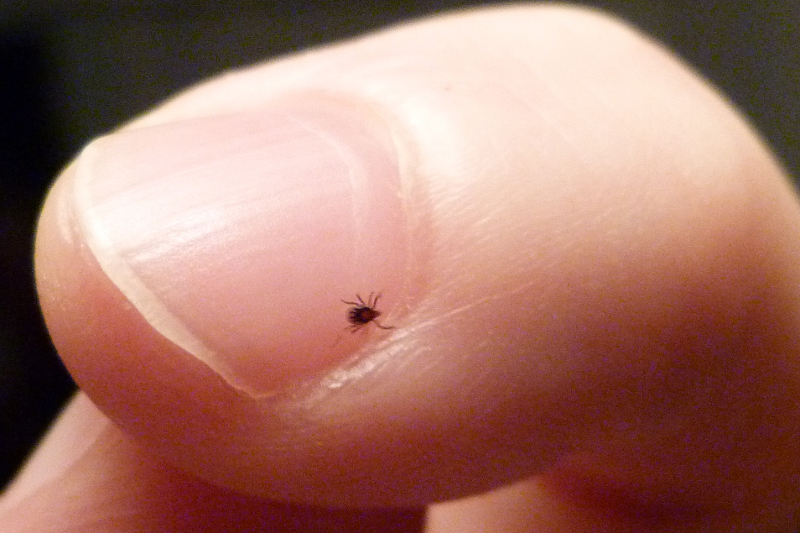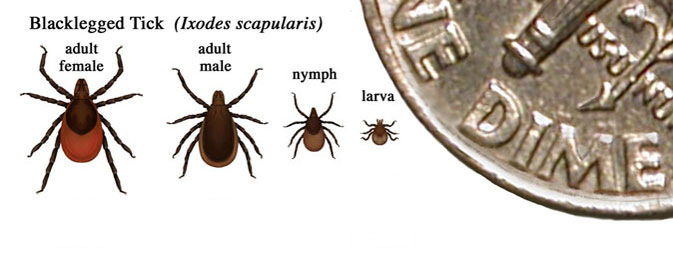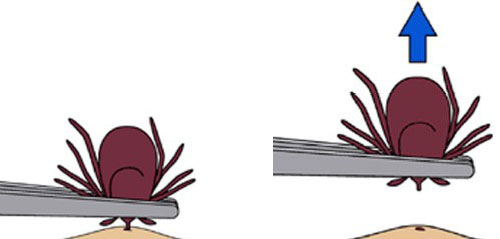Ticked off

How big is a deer tick nymph? Not very big. Photo: Creative Commons
Summer should be a carefree season full of picnics and swimming, a time for hikes and barbeques on the deck, not a time to fret about tick-borne illnesses. We want limes, not Lyme.
As few as ten years ago it was unusual to find even one brown dog tick or lone star tick on your person after a weekend of camping in northern NY state. Now in many places all you have to do is set foot in the brush to get several black-legged ticks, commonly known as deer ticks, which are harder to see than other ticks.
The deer tick is known to transmit Lyme disease as well as babesiosis, anaplasmosis, Powassan virus and other serious illnesses. In fact it’s possible for two or more diseases to be transferred to a host, human or otherwise, by a single tick bite.

Graphic: CDC
Most infections come from an immature or “nymph” stage deer tick, which can be tinier than a poppy seed and nearly impossible to detect (at least for those of us over fifty) without magnification. The adults are not exactly huge, being a bit smaller than a sesame seed. To avoid being bitten by ticks, people who work or play outdoors need to start taking precautions that weren’t necessary in the past.
This isn’t to say we need to panic. According to the National Institute for Health (NIH), only about 20% of deer ticks are infected with Borrelia burgdorferi, the spirochete bacterium that causes Lyme. In most cases, ticks must feed for 24-36 hours in order to transmit disease. And even in the case of transmission, prompt treatment cures Lyme in the majority of infected people.
However, it’s not always as simple as taking pills and feeling improvement. Unlike a tissue infection where antibiotics usually provide relief within days, Lyme symptoms can persist for weeks or months after the standard 3-week treatment has ended. In rare cases it can be a year or more. This is called “Post-Lyme Syndrome,” and its causes are not well understood. Lyme is not a disease to take lightly.
Avoiding ticks is the first order of business. Ticks “quest” at the tips of tall grass or brush, waiting to cling to the next warm body that brushes against them. The Centers for Disease Control and Prevention (CDC) recommend using products containing 20-30% DEET on exposed skin. Clothing, footwear and gear such as tents can be treated with products containing the active ingredient permethrin. Hikers should stick to marked trails.
Homeowners can clear brush, weeds and tall grasses from the edges of their yards. Ticks like to hide out under leaf litter (which is why sprays are not generally effective against them), so maintaining a yard perimeter that’s raked clean can help discourage ticks.
Pets should be treated regularly with an anti-tick product so they don’t bring deer ticks into the home. Talk to your vet about getting your pets vaccinated against Lyme (sadly there is no human vaccine at the moment).
Despite their name, deer ticks feed on—and infect—many wild critters, particularly our native and ubiquitous white-footed mouse. Because of ticks’ prevalence, people who spend a lot of time outside will eventually have contact with deer ticks. This is where tick hygiene comes in.

Tick removal technique. Graphic: CDC
Shower and wash thoroughly every evening and then check for ticks. Unfortunately they like hard-to-see places such as the armpits, groin, scalp and the backs of the knees, so look closely in these areas. If you find a tick has latched onto you, the CDC recommends you remove it by grasping it as close to the skin as possible with tweezers and pulling straight up until it releases. You may have to pull hard if it’s been feeding for some time. Don’t twist it or use heat, petroleum jelly or other home remedies to get it to release, as this can increase the chances of disease transmission.
Typical early symptoms of Lyme disease include severe headache, chills, fever, extreme fatigue, joint pain and dizziness. According to the International Lyme and Associated Diseases Society (ILADS is a nonprofit international medical society), fewer than 50% of people with Lyme Disease recall having a red, expanding “bull’s-eye” rash (erythema migrans) that may occur between 3-30 days after the bite. Symptoms can vary widely with each individual. These first signs may go away on their own, but the Lyme organism will cause more serious health issues in the future if ignored. These include arthritis, heart problems and debilitating memory loss and confusion.
If you’ve been bitten by a tick and have these symptoms, see your doctor right away. She or he can order a blood test, or may even prescribe antibiotics based on symptoms. For more information, go to the CDC website or to the NIH site. A comprehensive website is also hosted by ILADS.
This link will take you to a page where all types of ticks are identified and compared.







